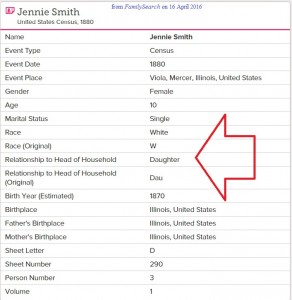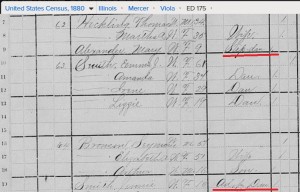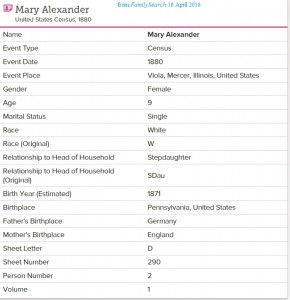It’s always advised to look at the original record. Transcriptions can easily be incomplete or incorrect. Those who simply copy a transcription into their database without questioning it can create additional confusion for themselves.
The 1880 United States census transcription at FamilySearch (and Ancestry.com) indicate that the ten-year old Jennie Smith living with the Seymour and Elizabeth Brownso n in Viola, Henry County, Illinois, is their daughter. She was not. Jennie’s biological parents are known and they have no known connection to the Brownson family. Her father was unable to take care of her and her mother died in the Mercer County poor farm–that’s where she was when the Brownsons adopted. Throughout her life Jenny alternates between Brownson and Smith as her “maiden name.”
n in Viola, Henry County, Illinois, is their daughter. She was not. Jennie’s biological parents are known and they have no known connection to the Brownson family. Her father was unable to take care of her and her mother died in the Mercer County poor farm–that’s where she was when the Brownsons adopted. Throughout her life Jenny alternates between Brownson and Smith as her “maiden name.”
The actual 1880 census does indicate the correct relationship between the Brownsons and Jennie Smith. The census refers to her as their adopted daughter. I’m not certain what directions were given to the transcriber, but the census enumeration is legible and clear.
There was another entry on the same census page for Jennie Brown that caught my eye. That was an entry for nine-year old Mary Alexander listed as step-daughter in the household of Thomas Hickling. 

Mary is listed in the transcription as a stepdaughter in the household.
So in addition to a reminder about the importance of looking at the original, we have one about assuming that transcriptions are consistent.

One response
I learned that the term “in law” may mean “by law”. For instance a man’s “daughter in law” may be what we now call “step daughter”; he is “by law” responsible for her.